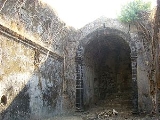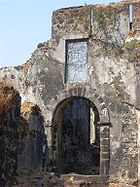
Korlai Fort
Encyclopedia
Korlai Fort is a Portuguese fortification in the town of Korlai, Maharashtra
, India. It was built on an island (Morro de Chaul) which guards the way to the Revdanda Creek. It was meant as a companion to the fort at Chaul
. At this strategic position the Portuguese could use it to defend their province which stretched from Korlai to Bassein. Vestiges of the Portuguese occupation are manifested in the distinct dialect of the Korlai villages inhabitants which is a Portuguese Creole called Kristi
.
with the permission of the Ahmednagar sultanate. In 1521, taking advantage of the confusion in the aftermath of the death of the Burhan Nizam the Portuguese tried to take over the fort. However the sultan retaliated and sent some of his best men to reclaim the fort. Subsequently a truce was reached in which the Ahmednagar sultanate occupied the island and no further fortification of the island took place. Only a wooden cross remained on the island as a sign of its former rulers.
However in 1594, Abranches, a Portuguese captain with 1,500 soldiers and 1,500 natives took possession of the fort. The besieged soldiers of the Sultanate tried to block their way by putting a dead elephant at the main gate and a dead horse at the inner gate. But in the end they had to surrender. The Portuguese won the fort but not having enough men to stand guard there chose to destroy it leaving only the central tower and a battery intact.
Before its destruction, Korlai had been described by travelers as a "magnificent fortress as strong as any other in the world". On the inland side - the only place where it was susceptible to be attacked it was protected by a ditch and could only be accessed by a drawbridge. The main entrance was guarded by a bronze lion and the highest tower by a bronze eagle. It housed 7,000 horses and as much men.
Some parts of it were rebuilt later but now had a garrison of only 50 men. The church within the fort was used for worship on Sundays and holidays. Korlai fort was also strategically very important as it guarded the mouth of the bay. Sambhaji
the son of Shivaji tried to take it over but failed and had to withdraw his forces on 6 December 1687. The fort was taken by the Marathas who held it from 1739-1818.

The fort is 2828 feet long, and its average breadth is eighty-nine feet. The enclosing wall is 5' 3" high and has 305 battlements for guns. It is entered by eleven gates - four are outer and seven are inner. At the north point, within pistol-shot of main battery is the water cistern named Santa Cruz - major source of water. The area within the fort walls is divided into three enclosures by two lines of bastioned fortifications. Each of the seven bastions bears the name of a saint. The two westward bastions are named São Diego(after Didacus of Alcalá
) and São Francisco (after Francis of Assisi
). The others are São Pedro, São Inácio, and São Filipe.
The top of the hill is bastioned as well and is and surrounded by a parapet. It has a large rain-water cistern with three mouths, each one foot wide, and the ruins of the magazine and a church. The church was built in 1630 for the use of the army and was functional until 1728.
There are three Portuguese inscriptions. One, over a doorway in the centre and highest part of the fort (see picture), reads as follows:
The inscription is surmounted by a cross with a coat of arms having the Portuguese stars in the centre and surrounded by seven castles. Other inscriptions over the main entrance and over an altar in the chapel are worn out and undecipherable. During the brief Maratha rule, some of the names of the bastions were changed but now the only indication of their presence is some dismantled shrines.
Maharashtra
Maharashtra is a state located in India. It is the second most populous after Uttar Pradesh and third largest state by area in India...
, India. It was built on an island (Morro de Chaul) which guards the way to the Revdanda Creek. It was meant as a companion to the fort at Chaul
Chaul
Chaul is a former city of Portuguese India, now in ruins. It is located 60 km south of Mumbai, in Raigad District of Maharashtra state in western India....
. At this strategic position the Portuguese could use it to defend their province which stretched from Korlai to Bassein. Vestiges of the Portuguese occupation are manifested in the distinct dialect of the Korlai villages inhabitants which is a Portuguese Creole called Kristi
Kristi language
Korlai Indo-Portuguese is the language of some 1,000 Christians in an isolated area around the village of Korlai in Raigad District of Maharashtra state, India...
.
History
This fort was built in 1521 by the PortuguesePortuguese India
The Portuguese Viceroyalty of India , later the Portuguese State of India , was the aggregate of Portugal's colonial holdings in India.The government started in 1505, six years after the discovery of a sea route to India by Vasco da Gama, with the nomination of the first Viceroy Francisco de...
with the permission of the Ahmednagar sultanate. In 1521, taking advantage of the confusion in the aftermath of the death of the Burhan Nizam the Portuguese tried to take over the fort. However the sultan retaliated and sent some of his best men to reclaim the fort. Subsequently a truce was reached in which the Ahmednagar sultanate occupied the island and no further fortification of the island took place. Only a wooden cross remained on the island as a sign of its former rulers.
However in 1594, Abranches, a Portuguese captain with 1,500 soldiers and 1,500 natives took possession of the fort. The besieged soldiers of the Sultanate tried to block their way by putting a dead elephant at the main gate and a dead horse at the inner gate. But in the end they had to surrender. The Portuguese won the fort but not having enough men to stand guard there chose to destroy it leaving only the central tower and a battery intact.
Before its destruction, Korlai had been described by travelers as a "magnificent fortress as strong as any other in the world". On the inland side - the only place where it was susceptible to be attacked it was protected by a ditch and could only be accessed by a drawbridge. The main entrance was guarded by a bronze lion and the highest tower by a bronze eagle. It housed 7,000 horses and as much men.
Some parts of it were rebuilt later but now had a garrison of only 50 men. The church within the fort was used for worship on Sundays and holidays. Korlai fort was also strategically very important as it guarded the mouth of the bay. Sambhaji
Sambhaji
Sambhaji Raje Bhosle was the eldest son and successor to Emporer Shivaji, the founder of the Maratha empire.- Early life :...
the son of Shivaji tried to take it over but failed and had to withdraw his forces on 6 December 1687. The fort was taken by the Marathas who held it from 1739-1818.
Major features

The fort is 2828 feet long, and its average breadth is eighty-nine feet. The enclosing wall is 5' 3" high and has 305 battlements for guns. It is entered by eleven gates - four are outer and seven are inner. At the north point, within pistol-shot of main battery is the water cistern named Santa Cruz - major source of water. The area within the fort walls is divided into three enclosures by two lines of bastioned fortifications. Each of the seven bastions bears the name of a saint. The two westward bastions are named São Diego(after Didacus of Alcalá
Didacus of Alcalá
Saint Didacus of Alcalá, , Saint Diego, was a lay brother of the Order of Friars Minor who died at Alcalá de Henares, Spain, November 12, 1463.-History:...
) and São Francisco (after Francis of Assisi
Francis of Assisi
Saint Francis of Assisi was an Italian Catholic friar and preacher. He founded the men's Franciscan Order, the women’s Order of St. Clare, and the lay Third Order of Saint Francis. St...
). The others are São Pedro, São Inácio, and São Filipe.
The top of the hill is bastioned as well and is and surrounded by a parapet. It has a large rain-water cistern with three mouths, each one foot wide, and the ruins of the magazine and a church. The church was built in 1630 for the use of the army and was functional until 1728.
There are three Portuguese inscriptions. One, over a doorway in the centre and highest part of the fort (see picture), reads as follows:
This castle was commanded to be built by the Viceroy of India Dom Filipe Mascarenhas in November of the year 1646 and Fernão Miranda Henriques being Captain of Chaul, and was finished in May 1680, Cristóvão de Abreu de Azevedo being Captain of this fort.
The inscription is surmounted by a cross with a coat of arms having the Portuguese stars in the centre and surrounded by seven castles. Other inscriptions over the main entrance and over an altar in the chapel are worn out and undecipherable. During the brief Maratha rule, some of the names of the bastions were changed but now the only indication of their presence is some dismantled shrines.
See also
- ChaulChaulChaul is a former city of Portuguese India, now in ruins. It is located 60 km south of Mumbai, in Raigad District of Maharashtra state in western India....
- List of forts in Maharashtra
- Portuguese IndiaPortuguese IndiaThe Portuguese Viceroyalty of India , later the Portuguese State of India , was the aggregate of Portugal's colonial holdings in India.The government started in 1505, six years after the discovery of a sea route to India by Vasco da Gama, with the nomination of the first Viceroy Francisco de...

